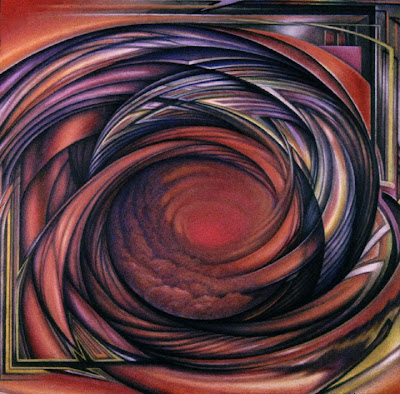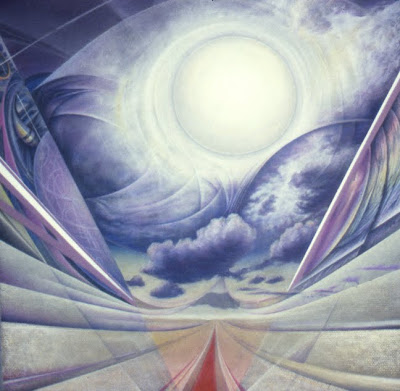
Tuesday, December 21, 2010
Thinking Solstice
My interest in ritual began when I heard about the research that showed that those who had longer sleep rituals went to sleep faster than those who jumped into bed and hoped for the best. If you take your time turning off lights, brushing teeth, fluffing pillows, the repetition of the same sequence sets the completion of the pattern in motion- falling asleep. The research focused on how the familiar sequence of steps triggered the associated brain chemistry, but I also remembered my early studies of perception, which emphasized pattern completion as one of the most basic organizing principles in seeing. Memory’s focus on prediction depends on recognizing patterns and anticipating what comes next. It’s a component of higher reasoning, and the more I thought about it the more pervasive it seemed to be. Since the sleep researchers were recommending that that people lengthen their sleep ritual to set the proper brain chemistry in motion, I added new steps setting up when I go to work in the studio. It’s effective and is one concrete way to make conscious use of the capacity to build patterns to get things done. In the creation of the right spatial temporal atmosphere, the act of preparing is sending signals through the brain that build a pattern that guides us into the rest of it. We create a form in space by our regular travels in any context, in the car, through grocery store, at work, within our home. Whatever becomes automatic moves to the cerebellum to free up more cortex to learn new things. The spectrum of human pattern making runs from the mundane to the sublime. The difference has less to do with the kind of pattern as much as the quality of our attention to it. Routines tend to be mindless. Rituals are mindful, bring attention and purpose together for the purpose of transforming a mental state.
When they took the ritual out of religion, it was robbed of its power. It may be one of the reasons that megachurches have caught on, using the rituals of rock-concerts, with lights, smoke, and music, to establish mental states of heightened brain chemistry, receptive to the sermon and unifying to the group. Ritual is behavioral alchemy, an engaging of the whole consciousness, of making one’s intentions concrete, demonstrating them by our actions. A ritual is an enacted image. If it’s repeated enough then a circuit is formed, that helps us enter the proper state of mind for the fullest experience.
Lining up with the solstice, holidays are an assembly of individualized rituals that pull us out of our regular actions so they don’t degenerate into mindless routine or burnout. They use lights to ward off the darkest time of year, have their own music and traditions and enact our connection to our larger community and the history associated with the holiday. Beyond the holiday the lesson of ritual is to live with reverence. Using the shape of our day we can build personally meaningful sequences of actions that train our capacity for attention. With every day shaped by an intentional pattern dedicated to being centered and in harmony with what’s unfolding around us, each stage is wide open for variation and conditioned for mindful attention. It’s one way we can consciously employ the natural functions of the brain.
When they took the ritual out of religion, it was robbed of its power. It may be one of the reasons that megachurches have caught on, using the rituals of rock-concerts, with lights, smoke, and music, to establish mental states of heightened brain chemistry, receptive to the sermon and unifying to the group. Ritual is behavioral alchemy, an engaging of the whole consciousness, of making one’s intentions concrete, demonstrating them by our actions. A ritual is an enacted image. If it’s repeated enough then a circuit is formed, that helps us enter the proper state of mind for the fullest experience.
Lining up with the solstice, holidays are an assembly of individualized rituals that pull us out of our regular actions so they don’t degenerate into mindless routine or burnout. They use lights to ward off the darkest time of year, have their own music and traditions and enact our connection to our larger community and the history associated with the holiday. Beyond the holiday the lesson of ritual is to live with reverence. Using the shape of our day we can build personally meaningful sequences of actions that train our capacity for attention. With every day shaped by an intentional pattern dedicated to being centered and in harmony with what’s unfolding around us, each stage is wide open for variation and conditioned for mindful attention. It’s one way we can consciously employ the natural functions of the brain.
Sunday, December 12, 2010
An Integrated Model
Whether we acknowledge it or not, our knowledge is mapped in an inner model that’s responsible for how we see reality. The layout of what we know was constructed by what happened to us, things we did and experienced and where. We laid down particular patterns and aligned new experience where it matched known relationships. This recognition of similar relations between parts, the matching calculus of unfolding events, is what we experience as understanding. New knowledge is layered in where it best fits the underlying patterns we already understand. Complexity theory tells us that as a system becomes more complex, the organizing structure either collapses under the weight of too much information or undergoes an overall reorganization. The crises we see all around us reflect the collapse of the guiding inner model.
The prevailing image of an isolated self, standing outside of a separate world, can’t hold the volume of new knowledge growing rapidly with technology. Technology’s abundance of informative pictures needs a new overview, a model that integrates and clarifies a better way to see reality.
The body itself might be a good starting point. We are multiple entwined systems, a weave of nerves and veins, muscles and organs, on the complex armature of the skeleton. It doesn’t stop there. For our digestive system to do its job we have to feed it. This entwines us in vast systems for the production and delivery of food. In food and sheltering ourselves we are woven into a system of roads and jobs and conveyances, cars, buses, trains, planes, and depend upon all of them being in good working order. There is interdependence between these systems and ourselves. We can’t do without them and we have a part in keeping it working. As much as heart and lungs depend on each other the group of systems that we are depends on the larger group of systems within which we’re embedded.
Our ego based image of an independent self must be shed. It pretends we’re self-sufficient. The idea that we are separate from our environment is a dangerous illusion that disregards the many systems we need for our survival. Even possessed of the skills to live in a cave and hunt, if the water is polluted you die. In a mindset that piles up goods for oneself, taking up space and draining resources, the image looks like a cancer on the larger system, growing recklessly, sucking health from the surrounding areas.
The intersect and interweave of systems information exists on all levels. Homeostasis is the way living systems adapt and adjust to keep balance. It provides insight into harmonious functioning within the model of reality as a complex multivariable organism. We are not in control of the systems that support us so must be flexible to survive. The art of adjustment, the ability to move fluidly through ideas, adapting, filtering and restructuring as necessary is the life art of a living system.
The prevailing image of an isolated self, standing outside of a separate world, can’t hold the volume of new knowledge growing rapidly with technology. Technology’s abundance of informative pictures needs a new overview, a model that integrates and clarifies a better way to see reality.
The body itself might be a good starting point. We are multiple entwined systems, a weave of nerves and veins, muscles and organs, on the complex armature of the skeleton. It doesn’t stop there. For our digestive system to do its job we have to feed it. This entwines us in vast systems for the production and delivery of food. In food and sheltering ourselves we are woven into a system of roads and jobs and conveyances, cars, buses, trains, planes, and depend upon all of them being in good working order. There is interdependence between these systems and ourselves. We can’t do without them and we have a part in keeping it working. As much as heart and lungs depend on each other the group of systems that we are depends on the larger group of systems within which we’re embedded.
Our ego based image of an independent self must be shed. It pretends we’re self-sufficient. The idea that we are separate from our environment is a dangerous illusion that disregards the many systems we need for our survival. Even possessed of the skills to live in a cave and hunt, if the water is polluted you die. In a mindset that piles up goods for oneself, taking up space and draining resources, the image looks like a cancer on the larger system, growing recklessly, sucking health from the surrounding areas.
The intersect and interweave of systems information exists on all levels. Homeostasis is the way living systems adapt and adjust to keep balance. It provides insight into harmonious functioning within the model of reality as a complex multivariable organism. We are not in control of the systems that support us so must be flexible to survive. The art of adjustment, the ability to move fluidly through ideas, adapting, filtering and restructuring as necessary is the life art of a living system.
Subscribe to:
Posts (Atom)
